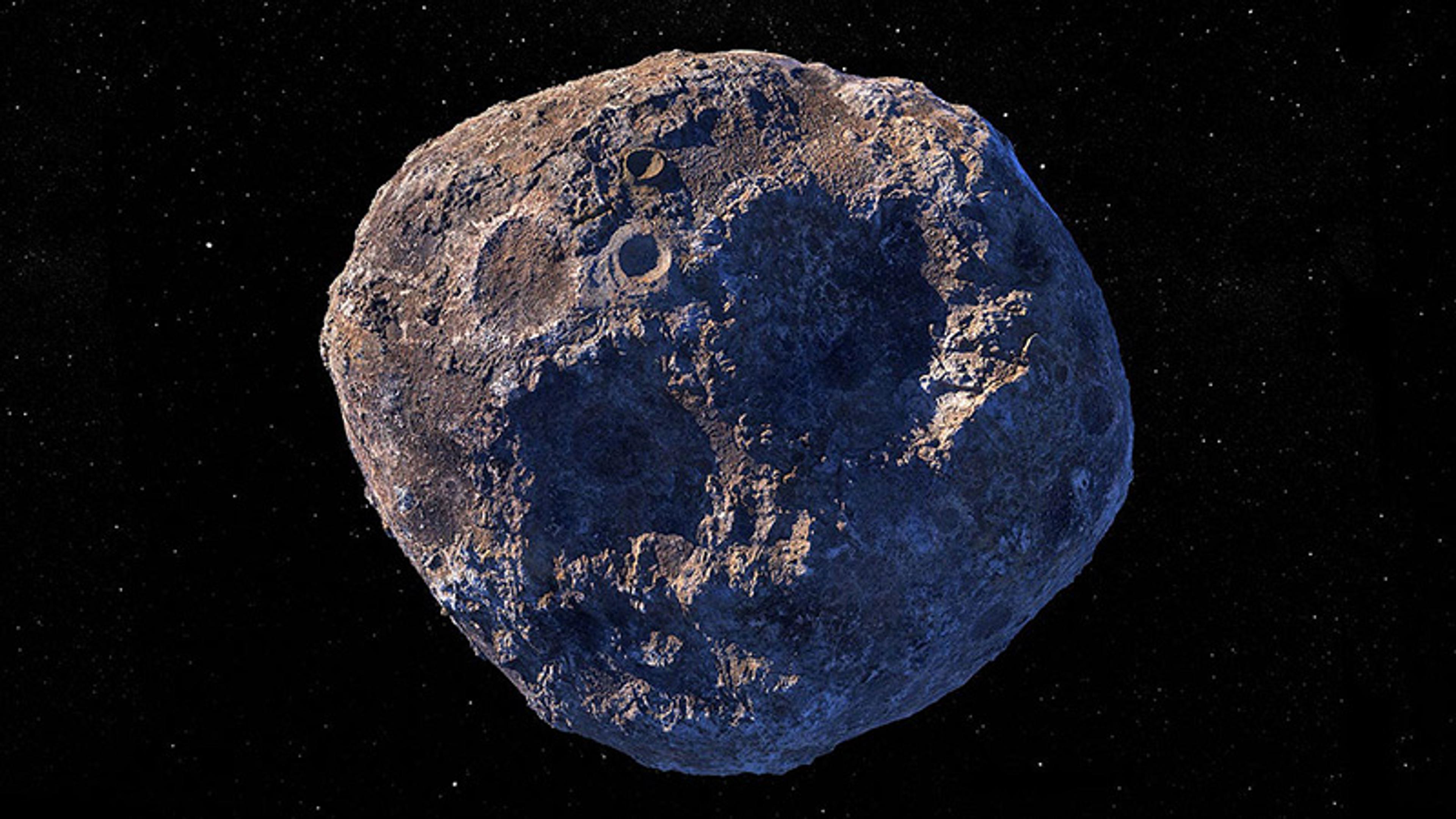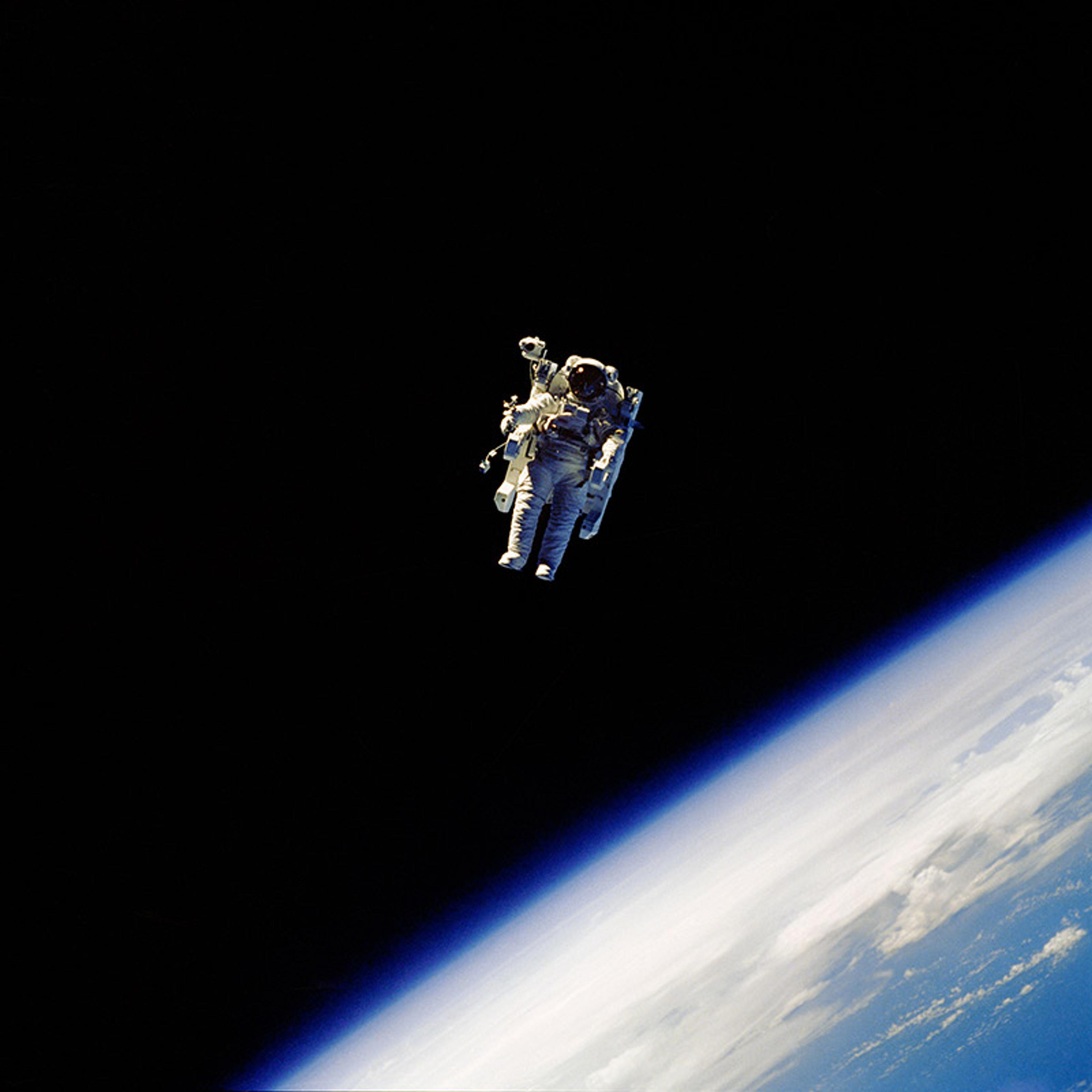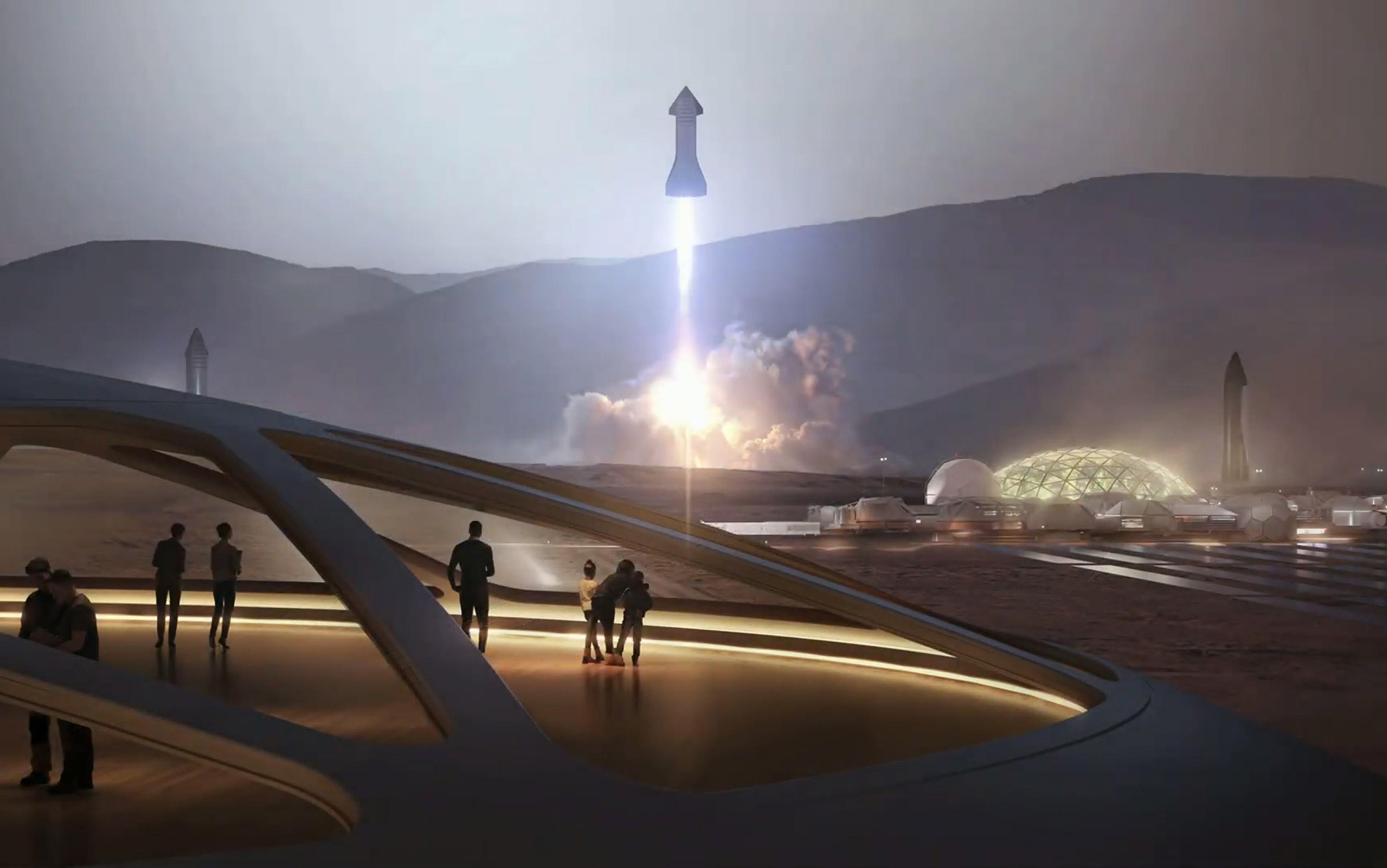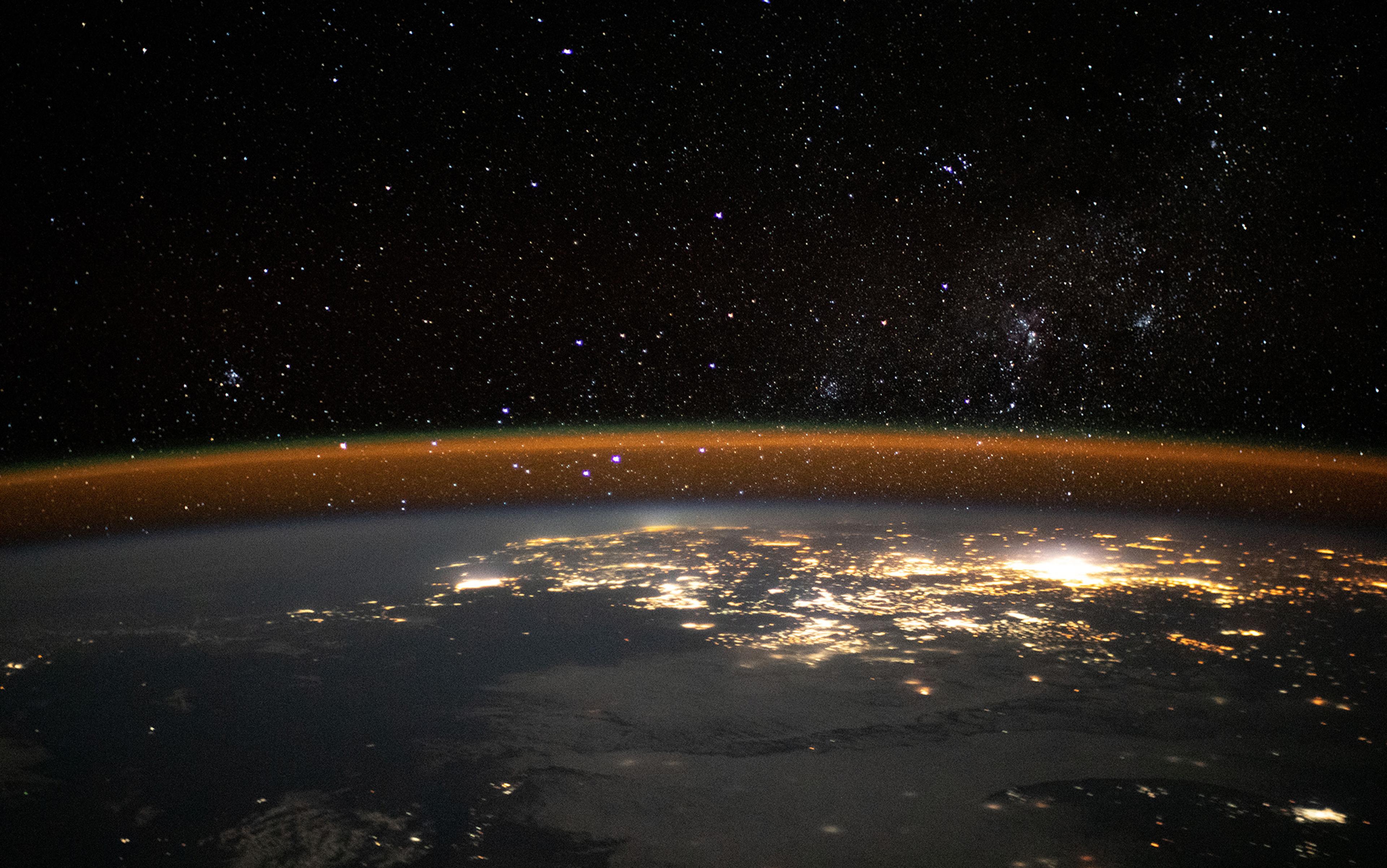When he rode to the edge of space on board Jeff Bezos’s reusable New Shepard rocket, William Shatner found the experience was not quite as he’d imagined. The Canadian actor famous for his phlegmatic captaincy of the starship Enterprise said on his return to Earth that ‘when I looked … into space, there was no mystery, no majestic awe to behold … all I saw was death.’
‘Everything I had expected to see was wrong,’ he went on. ‘The contrast between the vicious coldness of space and the warm nurturing of Earth below filled me with overwhelming sadness.’
It was an unusually astute and honest perspective on human spaceflight – but hardly the one Bezos, whose space-exploration company Blue Origin operates New Shepard, must have hoped to hear. Most of those who venture into space aren’t, like Shatner, taking up an offer out of sheer curiosity, but have already decided that this is indeed where humans should be heading. They are predisposed to relate the awe, splendour and adventure, but perhaps less inclined to question the whole enterprise more deeply.
Shatner’s brief voyage to the final frontier shared nothing of Star Trek’s vision of a united humankind, but was made possible by the eye-watering private profits of capitalism. When the US president John F Kennedy offered his rationale in 1962, at the peak of the Space Race – ‘We choose to go to the moon in this decade and do the other things, not because they are easy, but because they are hard’ – no one was under any illusion that the real motivation was Cold War rivalry. (There are, after all, plenty of other hard things one could do, but the Soviets had already beaten the United States into Earth orbit.) Yet still, it was deemed expedient for the US project to claim, when the lunar module of Apollo 11 touched down seven years later, that ‘We came in peace for all mankind.’
While today’s commercial spaceflight initiatives, such as Blue Origin, Elon Musk’s SpaceX and Richard Branson’s Virgin Galactic, still mobilise that utopian universalism, they are building a business. Others hope to profit from mineral resources mined in space. ‘For all mankind’ won’t cut it any longer; it is time to mothball the inherited rhetoric of the first space age, and to look honestly at the reasons human spaceflight is being pursued and at the ethical issues raised by both the current practices and the potential future goals.
For many in the space industry it is not obvious that there is any real ethics to discuss. In 2016, the astrophysicist Erika Nesvold asked the CEO of a (now-defunct) California space-mining company how he planned to address the danger that his proposed lunar mining equipment might contaminate the moon in ways detrimental to its scientific study. He told her: ‘We’ll worry about that later.’
Nesvold discovered that others in the private space industry had a similar response to dilemmas their plans raised. How will workers in space be protected from exploitation in such a vulnerable setting? How will interpersonal conflicts of people living in space be mediated and settled? Should there be property rights at all in space? If so, how would they be decided – and enforced? What obligations do we have to the space environment? What are the best structures for space governance, whether of activities in near-Earth orbit, planetary settlements or commercial activities? Who gets to go?
Rather than think about such issues, Nesvold wrote in her book Off-Earth (2023), many in the industry ‘seemed to be focused exclusively on technical challenges like reusable rocket designs, economic strategies for making space activities financially feasible, and legal structures that would invigorate rather than inhibit their industry’.
Take, for example, how everyone from advocates of space science to satellite companies to visionaries of the human colonisation of the galaxy looks admiringly at SpaceX’s efforts to make a reusable giant rocket, the Starship, the huge payload of which might benefit all those enterprises. So what if the project is led by a person increasingly drawn to far-Right conspiracy theories, who reportedly bullies staff or sacks them on a whim, whose commitment to free speech does not extend to the right of gender self-identification? It will all be fine. Give us the cool tech! We’ll worry about the ethics later.
But maybe let’s not. Maybe let’s worry now about the motives and the conduct of human space exploration in the modern commercial age. Let’s interrogate it openly and frankly, without the fuzzy slogans of inclusivity, before the Moon is being strip-mined and others discover, like Shatner but to their own cost, that life off-Earth is not quite what it’s been cracked up to be.
The only existing international agreement on conduct and obligations in space is the 1967 Outer Space Treaty, of which all the major spacefaring nations are signatories. The treaty declares that ‘the exploration and use of outer space shall be carried out for the benefit and in the interests of all countries and shall be the province of all mankind’, and that ‘outer space is not subject to national appropriation by claim of sovereignty, by means of use or occupation, or by any other means.’
The treaty was never drawn up with private space companies in mind, intent on turning space into another branch of the tourist industry or on exploiting its resources for personal gain. In the late 1960s, only governmental agencies were deemed capable of space exploration, and the treaty aimed to prevent nation-states from making extraterrestrial land grabs. But there are now several private businesses exploring technologies for mining water and minerals from asteroids, while NASA’s Artemis mission to return humans to the Moon, a first step towards a ‘long-term presence’, was developed in collaboration with commercial partners.
Despite such plans, the legal status of private property in space ‘remains murky and untested’, wrote Nesvold. In 2015, the US revised its position on the matter with the Commercial Space Launch Competitiveness Act, which states that US citizens who set out to extract resources from space ‘shall be entitled to any asteroid resource or space resource obtained, including to possess, own, transport, use, and sell [it] in accordance with applicable law’. The Act sought to evade possible conflict with the Outer Space Treaty by saying that such resource rights of companies would not imply any national ‘sovereignty … over, or the ownership of, any celestial body’. China and Russia, and possibly other nations with space programmes, are now drawing up their own legislation on private rights of ownership or extraction.

Asteroid Psyche is thought to be mineral rich. Courtesy NASA
These rights are being granted without any public discussion; we have no idea if this is what the public wants. Nor does that permission seem to be accompanied by codified duties of care. ‘Will future generations of humans in space struggle to live in a scarred, toxic landscape after years of unregulated mining, manufacturing, and waste disposal?’ asked Nesvold.
The popular narrative that space is a bottomless reservoir of resources does not fit the facts. The Harvard astrophysicist Martin Elvis estimates that only about 10 near-Earth asteroids are rich enough in valuable rare-earth metals to be worth the immense cost of mining. That may not be enough to satisfy the greed and ambitions of space-mining companies – and as a result, as Elvis told Nesvold, ‘we’ll have piracy and rustling and claim-jumping and espionage, all going on [in space]’.
‘Cosmocentrism’ asserts an intrinsic value even to the lifeless rocky landscapes of the Moon and Mars
Amid such competition, can there be any guarantee that these worlds won’t be ruined for scientific study? ‘There is a strong argument that the planets and their moons should be treated as sacrosanct and off limits, with one or two higher levels of protection than the US national parks,’ the planetary scientist Carolyn Porco tells me. Porco led the imaging science team on the Cassini (robotic) mission to Saturn from 2004 to 2017. ‘They are too scientifically important to be left open to commercial, political or colonialist purposes.’
Porco is currently involved with a future mission to Saturn’s moon Enceladus, considered by some to be the most likely extraterrestrial environment in the solar system to host life. ‘Would I trust a commercial outfit to take the necessary steps to ensure planetary protection on a moon like Enceladus?’ she asks. ‘Hell no!’ She would like to see ‘a stringent set of international regulations to prevent commercial interests [in space] from creating a “tragedy of the commons” as has happened with so many resources we have on Earth’.
An ability to study pristine outer space has benefits back home. ‘Our understanding of the greenhouse effect comes partly from work on the atmosphere of Venus,’ says the philosopher Tony Milligan of King’s College London. Venus has a runaway greenhouse effect, where the planet has become superheated by all its volatile substances evaporating into the dense atmosphere. ‘Planetary science just works better when you are studying more than one planet,’ Milligan tells me. ‘The science that shapes the climate-change response [thereby] improves – a lot.’
But some, eager to promote human spacefaring, oppose the idea that science must come first. ‘It’s not just a matter of who gave the Moon to astrobiologists, but also of who gave the Universe to professional scientists,’ wrote Robert Zubrin, president of the Mars Society, which advocates for Mars settlement. ‘Humans do not exist to serve scientific research. Scientific research exists to serve humanity.’
Others question whether the value of space environments should be assessed on utilitarian grounds in any event, whether that’s for the resources or the scientific insights they might offer. This perspective, called ‘cosmic preservationism’ or ‘cosmocentrism’, asserts an intrinsic value even to the (as far as we know) lifeless rocky landscapes of the Moon and Mars. It collides head on with the argument that there is, on the contrary, an ethical imperative to make a lifeless place like Mars fit for human habitation by ‘terraforming’ its atmosphere: a planetary equivalent of Israel’s first prime minister David Ben-Gurion’s mission to ‘make the desert bloom’. That was hardly an uncontroversial sentiment; neither is this.
Space mining and other commercial activities raise the question of workers’ rights. At face value, the situation might seem comparable to that in which any workers face remote and potentially dangerous conditions: in terrestrial mining or on oil rigs, say. But the dangers, the remoteness, the isolation – and hence the vulnerabilities of labourers – will be all the greater.
However, Milligan warns against imagining that space industries will conform to the sci-fi imagery of savage off-world worker colonies. ‘Only very highly skilled people are likely to be sent there to do any work, not a mass of dispossessed “belters” hewing at asteroids,’ he says. Most of the manual graft would be done by robots.
All the same, it seems likely that some workers will be needed and, as Nesvold warns: ‘History has shown us that the combination of potential profit and a vulnerable workforce can easily lead to labour exploitation, especially in a remote environment that’s difficult, if not impossible, to monitor for abuse.’
Although larger-scale planetary settlements remain highly hypothetical, rather little thought has been given to how they would be governed. The common assumption seems to be that they will be utopian democracies, but there is no reason why that must be so. Historical settlements in remote frontier locations are not exactly noted for their egalitarianism and tolerance. For example, any such communities with populations large enough to approach self-sufficiency will experience crime; with resources so scarce, would miscreants be deemed to deserve any of them at all?
While it might be far-fetched at this stage to imagine ‘billionauts’ like Musk and Bezos setting up settlements independently from any governmental support, it’s worth looking at the track records of their terrestrial enterprises. In 2017, SpaceX settled a lawsuit brought by employees who claimed to be given inadequate mealtimes and rest breaks; Musk’s Tesla electric-car factories have also been accused of dangerous and stressful working conditions, and have faced charges of union-busting and rampant workplace racism. Unsafe and oppressive working conditions have been reported in Bezos’s Amazon warehouses. It seems rather optimistic to imagine that the respect for human rights from private entrepreneurs would be better in the unforgiving environments of outer space. Musk has even floated the idea of offering prospective Mars settlers the opportunity to defray the enormous cost of their tickets by repaying the debt in labour on the Red Planet.
Many advocates of space settlement see regulation as a hindrance to innovation and entrepreneurship. Nesvold says they
tend to be neoliberal techno-utopians who believe that the very process of moving communities out from under the thumb of terrestrial oversight and governments into an environment with plenty of valuable, untouched resources will naturally improve society. By the very nature of these ideologies, one shouldn’t spend too much time thinking or planning for how to protect human rights or basic needs, because overplanning and over-regulation are Bad For Society.
Prospective pioneer settlers might want to consider how they feel about that.
The more immediate question is who gets to go in the first place. So far, space tourism has been largely confined to the rich and famous, while publicly funded astronaut programmes have not been beacons of diversity: no Apollo astronaut was other than white and male. Space agencies seem keen now to change that, but only in 2022 did Jessica Watkins become the first Black woman to serve on a long-duration mission on the International Space Station.
But things are improving, says Milligan. ‘Inclusion within space programmes, including the command structure, is a lot better than in the older industries or in politics. We really have moved on from “the right stuff”.’ The Artemis mission proclaims its intention to ‘land the first woman and first person of colour on the Moon’. And the second commercial spaceflight of Branson’s Virgin Galactic on 10 August 2023 carried the Caribbean mother and daughter Keisha Schahaff and Anastatia Mayers, who won their seats in a draw. Milligan points out that some of the ground-level training of First Nations people in NASA’s programme has happened on those individuals’ Indigenous lands ‘so that there is no sense of people being sent away from their own lands to be inculcated with somebody else’s way of seeing the world’.
Part of the problem is that, by its very nature, human spaceflight tends to draw from a limited demographic – if not in terms of race or gender, then certainly of mental and physical attributes. Some physical disabilities, such as might require a wheelchair on Earth, could be rendered moot in zero gravity, but could face serious obstacles on another planet. Mindful of this ableist history, in 2021 the European Space Agency launched its parastronaut feasibility project, calling for applicants with a specified range of physical disabilities in order to explore the possibilities of adapting spaceflight hardware (such as spacesuits) to such physiques.
Six months on the ISS exposes astronauts to about 100 times more radiation than a worker on a nuclear facility
‘Right now we are at step zero,’ the project announced. ‘The door is closed to persons living with disabilities. With this pilot project we have the ambition to open this door and make a leap, to go from zero to one.’ The first person accepted onto the programme, chosen in November 2022, is a British Paralympian named John McFall, who lost a leg in his late teens. The philosopher J S Johnson-Schwartz of Wichita State University in Kansas calls the programme ‘a step in the right direction’.
Then there is the question of what spaceflight demands mentally from its participants. The psychological attributes that might make for a good astronaut narrow the pool of neurotypes from which they are typically drawn. It is striking how Shatner – probably not, in real life, quite the ideal personality for astronautics – had a very different response to space from that of most candidates for NASA missions. In his classic study of the early Apollo missions Of a Fire on the Moon (1970), the US author Norman Mailer was unnerved by the dispassionate and clinical way in which Neil Armstrong and crew, and indeed the entire organisation, undertook an endeavour so imbued (as Mailer saw it) with spiritual dimensions. ‘Let us try to comprehend,’ he wrote, ‘how men can be so bold yet inhabit such insulations of cliché.’
Schwartz worries that, so far, the emphasis has been on mental and physical endurance. ‘We are doing what we can to learn whether any human bodies can survive at all in space,’ she tells me. ‘But our performance degrades when we don’t have what we need, when we’re confined in hostile environments. [So] we need to think about not eliminating human vulnerability in space, but acknowledging and accepting it.’
A resilient crew or settlement is going to need flexibility of thought, since there will be no manual with solutions to all the challenges they will face. ‘You need a lot of cognitive diversity in order to tackle new problems,’ says Schwartz: the old ‘test pilot’ mentality won’t suffice. ‘There’s virtually nothing we really know about how to make a human happy in space, how to sustain meaningful human lives in space,’ she adds.
Yet no matter how much we might strive to make space more welcoming, there’s no escaping the fact that the space environment is intensely hazardous. It is, you might say, always trying to kill us. This makes the popular comparisons with the sea voyages of Columbus and Magellan (which were of course in fact the beginning of the oppressive colonialist era) not just misleading but perhaps immorally so. ‘The more you learn about space, the more you realise how deeply uninhabitable it is compared to Earth,’ says Nesvold.

Far from the madding crowd: the astronaut Robert L Stewart using the nitrogen-propelled Manned Maneuvering Unit. He is floating without tethers attaching him to the space shuttle. Courtesy NASA
There’s obviously the extreme cold and the vacuum (or, on Mars, the lack of breathable air). But among the worst dangers is radiation: the constant bombardment from the high-energy particles of cosmic rays and the solar wind, which wreak molecular havoc in our biomolecules with potentially carcinogenic consequences. There are currently no good solutions. Spacecraft can’t carry heavy shielding, and weak shielding might be worse than none because it creates a potential source of cascading showers of secondary ionising particles. Six months on the International Space Station exposes astronauts to about 100 times more radiation than the expected dose for a worker on a nuclear facility, and around twice the permitted annual limit for those working with radioactive material. These doses are cumulative.
Given such health threats, Porco thinks that permanent space settlements are a fantasy. ‘When I review all the medical issues that have been found in astronauts thus far, I seriously doubt humans will be able to survive on Mars long term,’ she says.
Is it ethical even to pretend otherwise while no solution is known? Crewed missions to Mars would be prohibited by existing astronaut radiation exposure limits. NASA seems likely to give astronauts the option of waiving those limits if they choose to participate in such missions. But is it acceptable to permit individuals to expose themselves to such risk? Some will argue that acceptance of danger is the essence of all exploration, and that, in any event, the other risks of such a mission are likely to be at least as big. But, as the implosion of the Titanic submersible Titan has reminded us, the ethical calculus of risk is not merely a question of the freedom of individuals to enter hazardous environments.
Not least, such decisions depend in part on the motivations offered to participants. If, say, an astronaut believes that they are taking a risk for the sake of the future welfare of all of humanity, we are obliged to ask whether that belief has been formed with access to all the relevant information.
This brings us to the central ethical consideration: why go into space at all? When the Russian space visionary Konstantin Tsiolkovsky wrote in 1911 that ‘Earth is the cradle of humanity, but one cannot remain in the cradle forever’, he set the tone for the artful rhetoric of spaceflight by neglecting to add that outside the cradle is nothing but Shatner’s ‘vicious coldness of space’. Seen in that light, perhaps it is not so childish to stay put. Maybe ‘cradle’ is then the wrong metaphor.
There is only one answer that really stands up, though it is seldom expressed openly: we go not because it is hard, but because we think it would be cool. I share that feeling. To see a person walk on Mars would be extraordinary. It isn’t at all obvious that it would be worth all the risk and expense but, that aside, it would quicken my pulse.
‘I think that if most of us were being completely honest, this is the first and strongest reason we have for working on space,’ agrees Nesvold. ‘Emotion is such a strong driver, but when the stakes in money and in lives are this high, we need to recognise that we’re being driven emotionally and think about whether our actions are worth the cost.’
Instead – and this is where the matter becomes more of an ethical issue about honesty – the impulse is often defended with sophistry. We are often told that we need to colonise the stars or die out. We’d have to assume that those who point to the death of our own Sun in 5 billion years simply don’t understand evolution, but even the commonly invoked threat of existential risk from a meteorite impact is disingenuous. Since an impact that large is expected only once every several million years or so, the argument that we can’t possibly wait to see how we’re technologically fixed to find an escape route in a couple of centuries is feeble. (And, in any event, a Martian settlement obviously faces the same threat.)
What about the climate crisis? Over-population? Nuclear war? Resource exhaustion? But on the timescale on which we can meaningfully consider how these dangers might play out – say, a century or so – it is barely conceivable that there could be an autonomous, self-sustaining settlement on another world that could keep humanity alive. The old saw that ‘there is no Planet B’ is sadly apt.
This is not a debate distinguished for its rationality. ‘I’ve found that people arguing from the “we have to prevent the extinction of humanity” side can get extremely aggressive and toxic, because they believe their cause is literally the existence of the species, so any means is worth protecting those ends,’ says Nesvold. Of those who imply that getting into a rocket will save the human race, Schwartz points out that ‘the other people that say those things are generally cult leaders.’
‘Spaceflight is such a religion to some people that they don’t question the propaganda they hear about it,’ she says, ‘especially when it comes from scientists.’
If we enlist science as a cover for other motives, then we are not making an ethical case at all
Ah, science. That argument will not take us very far – literally. A crewed lunar observatory maintained with flights to Earth could be a nice addition to the many automated space-based telescopes already in operation. But the pace of advance in robotics and AI means it is even now highly questionable whether the additional cost and danger of getting fragile human planetary scientists to Mars in (a generous estimate) 30 years’ time would be a sound investment. Venturing any further afield is currently fantasy as far as human space science is concerned, whereas the return on investment for robotic missions has been phenomenal.
For many, ‘Why go?’ comes down to a human urge to explore. But is that really a universal urge? Nesvold points out that a tendency towards risk-seeking behaviour has been associated with a particular genetic disposition, specifically a variant of a gene called DRD4. But one of the most robust associations of this gene variant is in fact with the neurological condition ADHD, which Branson says he has. If this translates into an urge to go into space, that is surely not right or wrong in itself – but neither can it be claimed as some universal tendency. ‘Humans are diverse, we have lots of different tendencies, and it’s a fallacy to argue that just because something is “natural” [to some], it’s correct,’ says Nesvold.
Perhaps, then, the fundamental ethical issue of human spaceflight is about honesty. It is hard to consider ethical an enterprise that puts people at risk at immense cost and use of resources, if we do so under false pretences. If we pretend that space is like the oceans crossed by intrepid explorers, a promise of lush virgin territory over the horizon; if we mobilise that colonialist narrative for motivational purposes while suppressing the immense harm it caused; if we ignore what history tells us about human exploitation in outposts; if we enlist science as a cover for other motives, then we are not making an ethical case at all.
Has much changed in space ethics since Nesvold found it being shrugged off in 2016? ‘We [ethicists] are not playing a big role in the shaping of what goes on at the highest level,’ Milligan admits – but he adds that this isn’t unique to work on space. ‘Ethicists generally have a low-key role,’ he says – the same might be said of biotechnology, for example.
That’s not an easy position to sustain. ‘It’s disheartening that the message doesn’t get through,’ says Schwartz. ‘There’s a certain kind of hopelessness that researchers like me sometimes feel about this. We get dragged down by it.’
But Nesvold holds out hope for a richer discussion. ‘I was recently invited to attend an ethics workshop at NASA HQ, organised by an employee who wanted to bring in social scientists and ethicists to talk to others about ethical concerns with the Artemis programme,’ she says. ‘There was a bit of pushback during the conversations, but the fact that the workshop was held at all seemed like progress to me.’ A recent article in Science magazine by a group of bioethicists and legal scholars, exploring the wider ethical questions of commercial spaceflight such as dangers to the health of crew and passengers, and questions about inclusivity and use of natural resources, was another indication of growing recognition that the issues should be widely discussed.
‘The most important thing,’ she adds, ‘is that we have these conversations now, well before it’s too late.’






